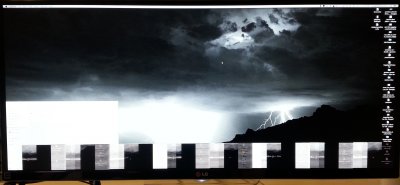- Joined
- Oct 16, 2011
- Messages
- 12
- Motherboard
- GA-Z77X-UD5H
- CPU
- i7-3770 3.4 GHz
- Graphics
- (integrated Intel HD-4000 driving single 1080P display)
- Mac
- Classic Mac
- Mobile Phone
Fixing display issue for 1440x3440 resolution, Intel HD4600 i5-4690K, Mavericks, Gigabyte 9-series
I've just built a system around a new LG UltraWide display, LG 34UM95-P (http://www.amazon.de/gp/product/B00HG7EB64/?tag=tonymacx8603-21), which requires HD4600 or greater integrated graphics (or modern discrete graphics card). The cards that are recommended add an extra 200€ to my build price and double (or more) the power draw, so, since I'm no gamer and don't do video editing and stuff very often, I figured I could just go with the integrated graphics. It's worked nicely for my previous builds done in the past couple of years. Choosing this display was partly driven by the reasoning that it keeps the build simple (getting multiple displays to work on a system with integrated graphics can be a bit of a pain and a single HD monitor is just not ideal for my work).
Anyway, I chose the GA-Z97X-Soc Force, since it was on the Buyer's Guide "motherboard list" here and I found a good price and it included DisplayPort, which I figured I'd want for addressing this display at appropriate resolution/refresh rate, etc. Anyway, it looks great during the setup process and looks fine attached to my MacBook (at lower refresh rate), but after the installation is all done and I'm booted up in Mavericks on this new system, the graphics are distorted at the bottom of the screen with this repeating pattern. I suspect it is the bottom past 1080 pixels (i.e. the bottom 360 pixels of the screen, between 1081 and 1440 pixels). See image... BTW, I get the same thing if I connect via HDMI (from that computer).
I'm using Mavericks since I'm not convinced I want to migrate to Yosemite, yet. I've not heard good things and don't want to pay for any upgrades (of other applications) just to use the latest OS X. I've also heard that Yosemite may not be ideal for using Intel integrated graphics. So I'm also open to recommendation/suggestion here and getting feedback about this. ;-)
Thanks for any help anyone can provide. I'd like to produce a guide for this mobo if I can get it working right (and otherwise am ready to move to the Asus Z-97A with Firewire add-on card, if this board is the real issue).
I've just built a system around a new LG UltraWide display, LG 34UM95-P (http://www.amazon.de/gp/product/B00HG7EB64/?tag=tonymacx8603-21), which requires HD4600 or greater integrated graphics (or modern discrete graphics card). The cards that are recommended add an extra 200€ to my build price and double (or more) the power draw, so, since I'm no gamer and don't do video editing and stuff very often, I figured I could just go with the integrated graphics. It's worked nicely for my previous builds done in the past couple of years. Choosing this display was partly driven by the reasoning that it keeps the build simple (getting multiple displays to work on a system with integrated graphics can be a bit of a pain and a single HD monitor is just not ideal for my work).
Anyway, I chose the GA-Z97X-Soc Force, since it was on the Buyer's Guide "motherboard list" here and I found a good price and it included DisplayPort, which I figured I'd want for addressing this display at appropriate resolution/refresh rate, etc. Anyway, it looks great during the setup process and looks fine attached to my MacBook (at lower refresh rate), but after the installation is all done and I'm booted up in Mavericks on this new system, the graphics are distorted at the bottom of the screen with this repeating pattern. I suspect it is the bottom past 1080 pixels (i.e. the bottom 360 pixels of the screen, between 1081 and 1440 pixels). See image... BTW, I get the same thing if I connect via HDMI (from that computer).
I'm using Mavericks since I'm not convinced I want to migrate to Yosemite, yet. I've not heard good things and don't want to pay for any upgrades (of other applications) just to use the latest OS X. I've also heard that Yosemite may not be ideal for using Intel integrated graphics. So I'm also open to recommendation/suggestion here and getting feedback about this. ;-)
Thanks for any help anyone can provide. I'd like to produce a guide for this mobo if I can get it working right (and otherwise am ready to move to the Asus Z-97A with Firewire add-on card, if this board is the real issue).
Attachments
Last edited:

